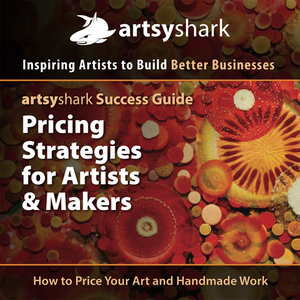by Carolyn Edlund
Pricing can be an uncomfortable subject for artists. Your mindset plays a role in how you price and position your products, the audience you choose, and your results.

Artist credit: Victoria B. Cooley
It’s not unusual for artists and makers to experience a lack of clarity or even wonder whether their work is “worthy enough” to price it profitably. Some artists may feel that they aren’t making anything that’s really “special” and therefore shouldn’t charge too much. Or, that the items they offer “didn’t take that much time” and thus require a lower price.
The truth is that even if other people could create the same things, they aren’t doing it. The artist is investing the time to design and make a body of work, and taking it to market. It’s important to understand how others view your work and the value they place on it. Prices can vary widely for art and handmade work. There are customers in every price range.
Don’t fall into a mind trap by thinking that “It’s all about price.” That is actually not true. You have the power to decide where you will sell your work. Will you choose physical or online venues that attract a more affluent audience? Or will you sell at events where the average price point is much lower? One thing you should know for sure is that bargain shoppers are not your audience. Don’t plan to be the cheapest seller in the marketplace to please them.
Artists and makers often start out on Etsy, or another similar online shopping site. Then, they find that someone else on that platform is selling items that are similar, but cheaper. This spurs them, out of fear, to move their own prices even lower.
The result? No one is making any money. Many vendors on these websites have no idea that they aren’t earning anything. Or, they may be hobbyists who only want to make the cost of their materials back. You cannot compete with them if you truly want to start a profitable small business. Lowering prices out of desperation is a race to the bottom.
Choose Your Market
So, what is your art worth? Art prices are mostly determined from sales history. If your mindset has been that you must charge low prices in order to sell, it will artificially keep your prices below where they could be. And, it could keep your prices too low, leaving money on the table.
It’s possible that you’ve been selling to the wrong customers all along, especially if you are waiting for them to come to you.
The truth is that you have the power to choose your customers. This is done by carefully selecting a market sector, and presenting your brand as worth more. The messages that you create and share with your audience also affect the perceived value of what you make. These decisions are strategic ways to position yourself as an artist that are empowering. You cannot control whether shoppers choose to purchase from you, but you can present your portfolio at a certain price range and in markets that can carry what you need to earn on a sale.
You are Not Your Customer
Avoid judging the value of your work or the prices that you set based on your own situation. It is entirely possible that you could never afford to buy your own artwork. That isn’t unusual. Artists are usually not peers of their ideal customers.
Can you sell artwork at a very high price point? Artists do it all the time. There are buyers with all sizes of pocketbooks, and you really never know the budget of a potential customer. They may be able to not only afford one piece of your work; they may have the ability to buy multiple pieces without a second thought. Knowing this, when speaking to potential collectors, go big and present some of your more expensive works first to gauge their reaction. If the price range is too high, you can move to lower-priced pieces. Don’t start with your low-priced work at first, however, because it’s harder to work up in price.
Do not make assumptions about what other people can afford. Rather than assuming that one purchase is all that is affordable for them, ask if they would like to see more of your work. If they say yes, you might end up with a multiple sale. If not, there is no harm done. Remain open to buyers and what they can afford, and you may be surprised to find that you sell more than you expected!
This is an excerpt from the Artsy Shark Success Guide: Pricing Strategies for Artists & Makers which contains pricing formulas, information about profit and markups, pricing fine art, adding value and much more.





Speak Your Mind